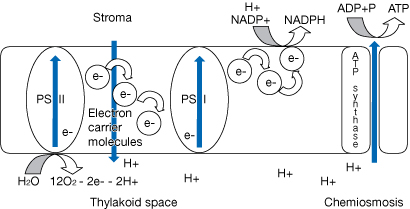Module 5 Intro
1. Module 5 Intro
1.12. Page 4
Module 5—Photosynthesis and Cellular Respiration
 Read
Read
The Path of Electrons in Light-Dependent Reactions
You may choose to read the following description or read pages 172 to 174 of the textbook before you watch the animation “Oxygenic Photosynthesi” in the next Watch and Listen. This animation clearly shows the path of electrons in the light-dependent reactions of photosynthesis.
photosystem: a cluster of light-absorbing pigment molecules in the thylakoid membrane of chloroplasts
NADP+: nicotinamide adenine dinucleotide phosphate in its oxidized state
NADPH: nicotinamide adenine dinucleotide phosphate in its reduced state; used in light-independent reactions to form glucose
ATP synthase: an enzyme that bonds free phosphates to ADP to form ATP
The electron transport chain that exists in the thylakoid membrane involves photosystem I and II. Photosystem II (PSII) absorbs all wavelengths of light allowed by its pigments. When light is absorbed, energy is transferred to a designated reaction-centre molecule. The reaction centre becomes “excited.” This means that an electron will want to move to a higher energy level, so the electron leaves to catch the electron-transport chain. PSII oxidizes water molecules to provide hydrogen ions for chemiosmosis and electrons to replace the electrons leaving the “reaction centre.” Oxygen is produced at this step.
The electron from photosystem II travels down the electron-transport chain. Every encounter with an electron-carrying molecule releases energy. This energy pushes H+ from the stroma into the thylakoid space. A hydrogen ion concentration gradient is formed. This gradient will be used to produce ATP from ADP (adenosine diphosphate) and free phosphate groups.
The e- (electron) from photosystem II reaches photosystem I (PSI). Light has also been absorbed by PSI. The energy has been passed on to the reaction centre. A highly energized electron leaves photosystem I to be replaced by the e- from PSII at the end of its electron-transport chain. The highly energized electron from PSI moves down an electron-transport chain. The electron is used to reduce NADP+ to form NADPH. NADP+ gains electrons from PSI and hydrogen ions.
Lastly, remember that hydrogen ions are building up in the thylakoid space. Once a hydrogen ion is in the thylakoid space, it cannot diffuse back to the stroma. However, ATP synthase embedded in the thylakoid membrane will move H+ down the concentration gradient (high [H+] in the thylakoid space to low [H+] in the stroma). The energy from this concentration gradient is chemiosmosis. ATP is created.
Light-dependent reactions produce oxygen, which is released from chloroplasts to the atmosphere. Light-dependent reactions produce intermediate products of NADPH and ATP. These molecules are required in light-independent reactions for the production of glucose.
The following diagram is a summary.

 Watch and Listen
Watch and Listen
The Path of Electrons in Light-Dependent Reactions
Watch the animation “Oxygenic Photosynthesis” or watch the animation “Photosynthetic Electron Transport and ATP Synthesis.” Note that these animations label molecules in the electron-transport chain that you are not required to know. You just need to realize these molecules are electron-carrying molecules. However, the molecules clearly show the path of electrons in the light-dependent reactions of photosynthesis. You may want to refer to a copy of the summary diagram as you watch the animation.
If you prefer to be in control of the animation speed, select “Oxygenic Photosythesis.” If you prefer to have audio with an animation, watch “Photosynthetic Electron Transport and ATP Synthesis.”
Now watch this Cyclic and Noncyclic Photophosphorylation animation. Which animation helped you better understand the light-dependent reactions of photosynthesis? Did the reading and/or diagram help you as well?
 Self-Check
Self-Check
SC 6. Complete this Self-Check activity to check your understanding of light-dependent reactions.